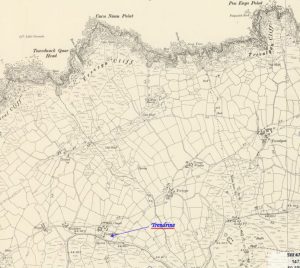

Trendrine (TR26 3BW) is off the B3306 road between Hellesveor and Zennor. It is in the parish of Zennor and is an unspoilt coastal hamlet set in the ancient field system of this part of Cornwall. Trendrine Hill is of historic importance due to round barrows and there is much evidence of settlements in the area dating back hundreds of years. This profile of the Wesleyan Chapel has been compiled by Val Thomas of St Ives Old Cornwall Society.
 Trendrine Chapel (Image from the David Allan Collection held by the St Ives Museum)
Trendrine Chapel (Image from the David Allan Collection held by the St Ives Museum)
1841: The census shows Trendrine has 9 separate dwellings with 34 people registered in the hamlet.
1843: This chapel was founded in a converted farm building and had seats for 90.
1851: William Burgess completed the return for the chapel.
1871: There are 6 dwellings on the census with tin mining and farming the main occupations.
1873: It is shown as an “other preaching place” and reports 100 seats.
1877-1887: When looking at the map which was published in 1887 there are several homes and the chapel.
1904: 188 acres of land at Trendrine were sold as part of the Duke of Bolton’s Estate. He was a very important landowner until this time but on his death his estate in Penwith appears to have been sold, much of it to Mr Edward Hain who was a large shipping owner from St Ives.
1906: Only Philip Eddy is shown on the Towednack Polling register as living in Trendrine.
1908: The hamlet seems to consist of just the enclosed farmyard and a few homes. The Chapel is clearly named though.
1924: The electoral register shows John Quick Eddy, Nannie Penrose Eddy, Philip Osborne Eddy and Jane Quick Eddy living at Trendrine.
1930: Trendrine formed part of the Porthia Estate which was being sold by the owner, Mrs Kate Bullivant who inherited it on the death of Edward Hain. The farm is 190 acres and let to Mr A.C. Eddy; house, building and cottage. The Eddy family lived there until 1944 and one of the hills is known as ‘Buttermilk Hill’ as they kept Guernsey cows for their milk, cream and butter. The family won many awards for their milking and butter production, including a butter competition held in Northallerton, Yorkshire in 1913. Mrs Eddy of Trendrine, Zennor was an aunt to Dr John Quick who received a knighthood in Australia in 1901. After this the farm was taken over by the Nankervis family.
I can find no newspaper entries regarding the chapel at all, and there appear to be no records as such.
Trendrine has many ‘listed’ features including Trendrine Cottage, front garden wall and gate piers, the farm buildings immediately west of Trendrine cottage. Walk 1081, the St Ives and Coastal Path from Zennor walk through the fields takes you through the farmyard of the house.
 The farm pictured recently
The farm pictured recently
The closure date is being sought.
Resources:
(Image from the David Allan Collection held by the St Ives Museum)
West Penwith Resources: Chapel part 3 and The Porthia Estate particulars,
National maps of Scotland

My Parents Mr A.Wilton Smith and Mrs Dapne Smith bought Trendrine Farm in 1952 , .The long pig stye was turned into a dwelling that housed my Grandmother ,.Trendrine Cottage was home to my Great Grandmother untill she died.The cottage then became part of the wages for the farm hand.the large Farm house was lived in By my parents , my brother and I.
Thw chapel was let out as a home as was the cottage , later being rented out to holiday makers.My parents sold the farm on in 1970. It has since fallen in to disrepair.The owner being a single elderly women raising beef cattle.